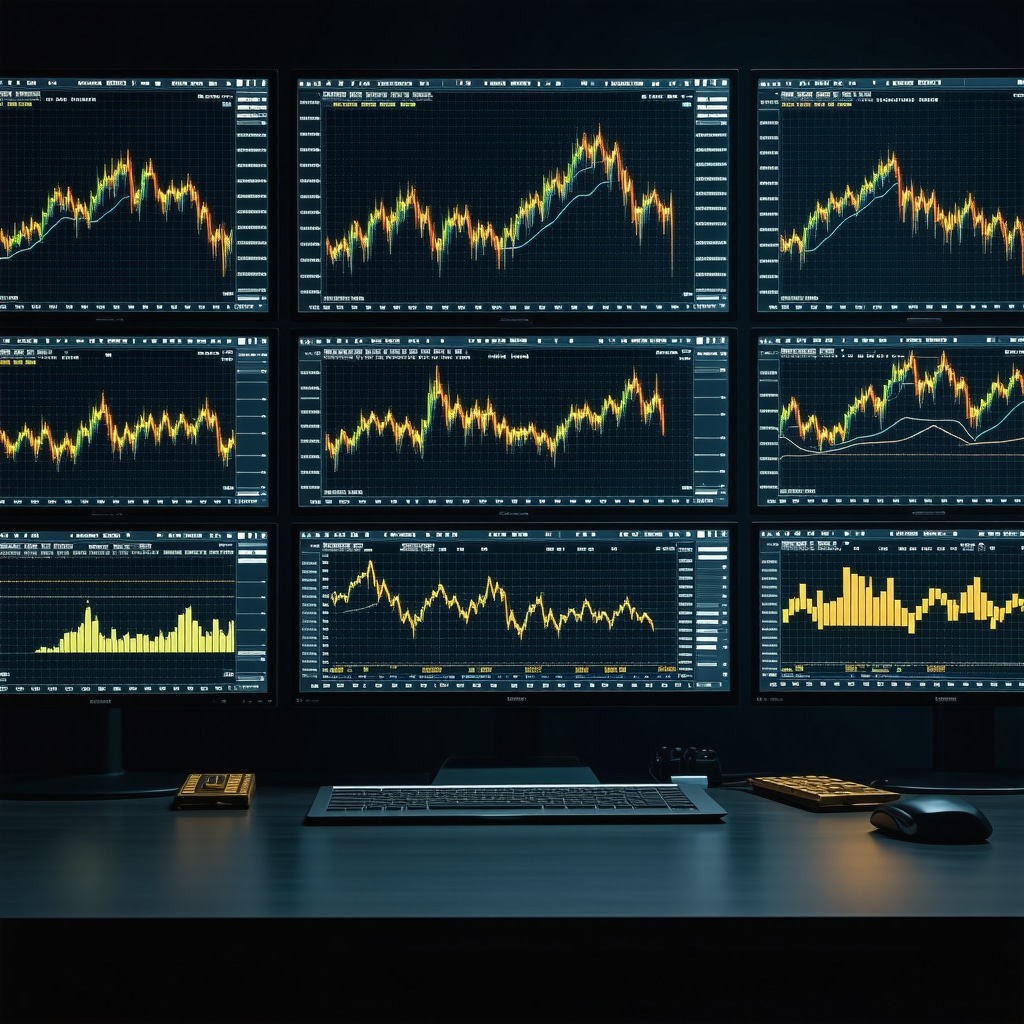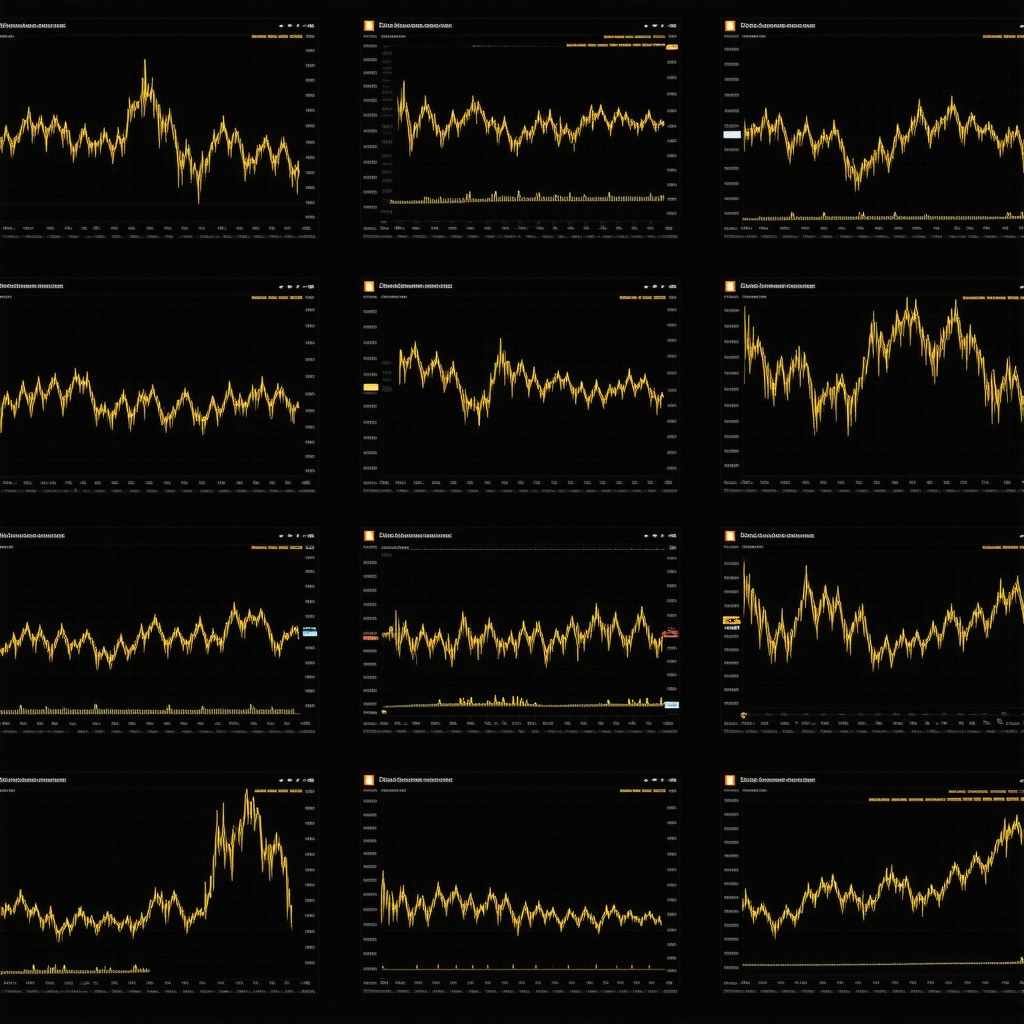Unlocking Gold’s Hidden Potential: Trading Strategies for the Modern Investor
In the ever-evolving landscape of precious metals, gold remains a beacon of stability and opportunity. However, thriving in gold trading in 2025 demands more than just intuition—it requires a nuanced mastery of market dynamics and innovative techniques tailored to today’s financial climate. This guide unveils sophisticated gold trading strategies designed to cultivate consistent profits, empowering traders to navigate volatility with confidence and precision.
Decoding Market Swings: Leveraging Technical Analysis for Gold Trading
Technical analysis stands as a cornerstone for effective gold trading techniques. By interpreting price charts, identifying patterns, and utilizing indicators such as Moving Averages and the Relative Strength Index (RSI), traders can anticipate market movements before they unfold. For instance, recognizing a “golden cross” — where a short-term moving average crosses above a long-term moving average — often signals a bullish trend that savvy traders exploit for gains. Integrating these insights with volume analysis refines entry and exit points, enhancing profit consistency.
Precision Timing: Capitalizing on Gold Futures and Options
Gold futures and options introduce a powerful dimension to trading, offering leverage and hedging capabilities. Understanding contract specifications, expiration cycles, and volatility metrics is essential. Experienced traders often employ strategies like spread trading to minimize risk while maximizing returns during turbulent periods. This approach requires meticulous market observation and a disciplined risk management framework, ensuring resilience against sudden price swings.
How Can Advanced Risk Management Enhance Gold Trading Profitability?
Risk management is pivotal in transforming gold trading from speculative to strategic. Techniques such as setting stop-loss orders, position sizing based on volatility, and diversifying across multiple gold instruments protect capital against adverse movements. Incorporating algorithmic alerts and psychological discipline further mitigates emotional decision-making, a common pitfall for traders. These methods collectively foster consistent profitability by balancing ambition with prudence.
Integrating Fundamental Insights: Navigating Gold Demand and Supply Dynamics
Beyond charts and contracts, understanding the macroeconomic forces shaping gold prices is crucial. Factors such as geopolitical tensions, inflation rates, central bank policies, and mining outputs profoundly influence gold’s trajectory. For example, increased gold demand from emerging markets or disruptions in supply chains can trigger price surges ripe for strategic trading. Staying informed through authoritative analyses, like those found at World Gold Council, equips traders with the foresight needed to adapt tactics effectively.
Embracing Technology: Utilizing Cutting-Edge Trading Tools and Platforms
Modern gold traders harness advanced trading applications that offer real-time data, customizable alerts, and integrated analytics. Platforms with AI-driven predictive models and sentiment analysis provide a competitive edge, enabling traders to act swiftly on emerging trends. Coupling these tools with disciplined strategy implementation can significantly enhance trade execution and profit reliability.
For those seeking to deepen their expertise, exploring the effective gold trading techniques to capitalize on market swings offers valuable practical knowledge and nuanced strategies tailored for 2025’s market environment.
If you found these insights valuable, share your thoughts or trading experiences below—your perspective enriches our community’s collective wisdom.
Reflecting on My Journey with Gold Trading Tools
When I first dove into gold trading, I underestimated how transformative technology could be. Early on, I relied heavily on manual chart reading and basic alerts, which often left me reacting late to market swings. But as I integrated AI-powered platforms offering real-time sentiment analysis and predictive analytics, my approach shifted dramatically. These tools didn’t just provide data; they offered actionable insights that helped me anticipate shifts, refine entry points, and manage risks more effectively.
For example, one of my favorite platforms incorporates machine learning algorithms that analyze global news and social media trends to gauge market sentiment around gold. This feature became a game-changer during volatile periods, allowing me to position trades ahead of major price movements.
Balancing Intuition with Data: My Personal Trading Philosophy
Despite the allure of advanced tools, I’ve learned that successful gold trading blends data-driven strategies with personal intuition honed through experience. I often ask myself, “What story is the market telling beyond the numbers?” This narrative approach helps me contextualize technical signals within broader economic and geopolitical developments, making my trades more holistic and informed.
What’s Your Approach to Combining Technology and Intuition in Trading?
I’m curious—how do you balance the cold precision of technology with the gut feelings that come from experience? Have you found moments where intuition saved you or where tech tools prevented costly mistakes? Sharing these stories can illuminate different paths to success in gold trading.
Deepening Insights: The Role of Global Demand Trends
Understanding the underlying demand trends for gold is another layer I’ve grown to appreciate. Beyond just watching prices, I follow reports on jewelry demand, central bank buying patterns, and industrial uses, since these factors influence supply-demand balance and thus pricing. The insights on gold demand and price drivers in 2025 provide an excellent framework for interpreting these shifts, which can help traders anticipate and ride market waves more confidently.
For instance, when emerging markets show increased appetite for gold jewelry, it often signals sustained demand that supports price levels. Similarly, central banks’ strategic acquisitions can indicate hedging against economic uncertainty, affecting market sentiment.
Practical Wisdom: Managing Emotions in High-Stakes Trades
One of the toughest lessons I’ve learned is managing emotional responses during high-stakes gold trades. Volatility can tempt impulsive decisions, but I’ve found that a disciplined routine—setting clear stop-loss points, using algorithmic alerts, and stepping back to reassess—helps maintain clarity. This emotional discipline not only protects capital but also fosters long-term resilience.
If you’re looking to build this skill, consider incorporating mindfulness techniques or trading journals to reflect on your decision-making patterns. These small practices can transform your trading mindset profoundly.
If you’ve had experiences blending technology and intuition or managing emotions in gold trading, I’d love to hear your stories. Drop a comment below or explore more on effective gold trading techniques to capitalize on market swings to deepen your strategy arsenal.
Algorithmic Trading: Harnessing Quantitative Models to Optimize Gold Investment
In the realm of gold trading, algorithmic strategies have revolutionized how investors approach market opportunities. These automated systems leverage complex quantitative models and historical data to execute trades with precision and speed unattainable by human intervention alone. By integrating machine learning techniques, traders can identify subtle patterns and correlations within vast datasets, including price fluctuations, macroeconomic indicators, and sentiment signals.
For instance, mean reversion algorithms capitalize on gold’s tendency to revert to its long-term average price, allowing traders to enter positions when prices deviate significantly. Meanwhile, momentum-based algorithms exploit trend persistence, dynamically adjusting exposure as price trajectories evolve. Crucially, the efficacy of these models depends on robust backtesting against diverse market conditions to mitigate overfitting and ensure adaptability.
How Do Market Sentiment Indicators Complement Algorithmic Gold Trading?
Market sentiment indicators, derived from sources such as social media analytics, news sentiment scores, and investor positioning data, provide a vital layer of context often overlooked by purely quantitative approaches. When integrated into algorithmic frameworks, sentiment analysis can preempt shifts in trader behavior and macroeconomic narratives that drive gold prices.
For example, a sudden surge in bearish sentiment amidst otherwise stable technical indicators might signal an impending reversal, prompting algorithms to adjust strategies accordingly. Conversely, positive sentiment spikes can validate momentum trades, enhancing confidence in upward trends. This synthesis of quantitative models with qualitative sentiment data reflects a sophisticated, hybrid approach that elevates gold trading precision.
Macro-Hedging Strategies: Aligning Gold Trades with Global Economic Indicators
Advanced traders recognize that gold’s price movements are inextricably linked to global economic variables such as real interest rates, currency fluctuations, and geopolitical risk factors. Implementing macro-hedging strategies involves constructing portfolios that dynamically adjust gold exposure based on predictive economic models.
For example, during periods when real interest rates turn negative—a historically bullish scenario for gold—traders might increase long positions or deploy options strategies to capitalize on anticipated price appreciation. Additionally, currency-hedged gold ETFs allow investors to mitigate forex risk while maintaining exposure to gold’s intrinsic value.
Staying abreast of authoritative economic forecasts, such as those published by the International Monetary Fund (IMF Data Portal), equips traders with the foresight to anticipate market shifts and recalibrate their hedging tactics proactively.
Integrating Behavioral Finance: Overcoming Cognitive Biases in Gold Trading Decisions
Despite technological advancements, human psychology remains a critical determinant of trading outcomes. Behavioral finance studies reveal that biases such as confirmation bias, loss aversion, and herd mentality disproportionately influence gold traders, often leading to suboptimal decision-making.
To combat these pitfalls, expert traders implement systematic frameworks incorporating pre-defined trade plans, algorithmic alerts, and periodic performance reviews. Additionally, employing quantitative metrics to evaluate trade outcomes objectively can diminish emotional interference and foster disciplined execution.
Developing awareness of these cognitive traps and cultivating a mindset oriented towards continuous learning and adaptability is essential for sustaining long-term success in the volatile gold markets.
If you’re ready to elevate your gold trading approach with cutting-edge algorithmic models and behavioral insights, explore our comprehensive resources and join the conversation with seasoned experts. Your journey toward mastery starts here.

Algorithmic Trading Enhanced: Merging Quantitative Precision with Behavioral Finance
While algorithmic models provide unparalleled speed and accuracy in gold trading, their integration with behavioral finance principles marks a transformative advance. Understanding cognitive biases such as overconfidence and anchoring allows traders to refine algorithm parameters and avoid pitfalls inherent to purely mechanical systems. This synergy fosters a more resilient trading strategy that adapts not only to market data but also to the psychological undercurrents influencing price movements.
What Are the Best Practices for Integrating Behavioral Metrics into Algorithmic Gold Trading Models?
Expert traders recommend embedding behavioral metrics like sentiment scores and volatility-adjusted confidence intervals directly into algorithmic frameworks. This involves leveraging machine learning classifiers trained on historical trade outcomes correlated with psychological indicators, enhancing the model’s predictive capabilities. Furthermore, continuous model retraining with real-time feedback loops ensures adaptability to evolving market psychology and prevents overfitting to past behavioral patterns.
For a deeper exploration of this advanced methodology, the CFA Institute’s research on behavioral finance in algorithmic trading offers invaluable insights grounded in rigorous academic analysis.
Leveraging High-Frequency Data Streams: Real-Time Decision-Making in Gold Markets
High-frequency data acquisition, encompassing tick-level price changes and order book dynamics, empowers traders to detect microstructure anomalies and exploit fleeting arbitrage opportunities in gold trading. By deploying sophisticated event-driven algorithms that react to these data streams, traders can execute trades within milliseconds, capturing value imperceptible to traditional strategies. This approach demands robust computational infrastructure and rigorous risk controls to mitigate the amplified market noise and latency risks.
Adaptive Portfolio Construction: Dynamic Gold Allocation Amidst Macroeconomic Shifts
Advanced portfolio managers adopt adaptive allocation strategies that dynamically recalibrate gold exposure in response to real-time macroeconomic indicators such as inflation surprises, currency volatility, and geopolitical event triggers. Utilizing Bayesian inference and state-space models, these strategies update probabilistic assessments of gold’s risk-return profile and adjust positions accordingly. This continuous learning framework enables superior risk-adjusted performance compared to static allocation methodologies.

Expert Techniques to Mitigate Slippage and Execution Risk in Gold Trading
Execution risk and slippage remain critical challenges in active gold trading, particularly when deploying large or algorithm-driven orders. Leading traders employ techniques such as iceberg orders, volume-weighted average price (VWAP) algorithms, and smart order routing to minimize market impact and optimize fill quality. Incorporating predictive analytics to schedule trades around liquidity windows further refines execution efficiency, directly influencing net profitability.
Embracing these nuanced execution strategies alongside advanced analytics can markedly elevate your gold trading performance, transforming theoretical models into practical success.
If you are ready to harness these cutting-edge insights and elevate your gold trading expertise, engage with our expert community or explore comprehensive resources tailored for sophisticated investors.
Frequently Asked Questions (FAQ)
What distinguishes algorithmic trading from traditional gold trading methods?
Algorithmic trading utilizes automated systems and quantitative models to execute trades at speeds and precision unattainable by manual methods. It leverages historical data, machine learning, and real-time analytics to identify patterns, optimize entry and exit points, and manage risk dynamically—enabling traders to capitalize on microsecond market opportunities and reduce emotional biases inherent to manual trading.
How can behavioral finance improve gold trading performance?
Behavioral finance helps traders understand and mitigate cognitive biases such as overconfidence, loss aversion, and herd mentality that often lead to suboptimal decisions. By integrating behavioral metrics into trading strategies or algorithms, traders can more objectively evaluate decisions, maintain discipline, and adapt to psychological market influences—ultimately fostering a more resilient and consistent trading approach.
Why is real-time data critical in gold trading?
Gold markets can shift rapidly due to geopolitical events, economic indicators, or market sentiment changes. High-frequency data streams provide tick-level price information and order book dynamics that enable traders to detect fleeting arbitrage opportunities and microstructure anomalies. Utilizing this data allows for faster, more informed decisions that can significantly enhance trade execution and profitability.
What role do macroeconomic indicators play in gold trading strategies?
Macroeconomic factors such as real interest rates, inflation, currency fluctuations, and geopolitical risks directly influence gold prices. Advanced traders use predictive economic models and real-time indicators to adjust gold exposure dynamically, employing macro-hedging strategies that align with anticipated market movements—helping optimize risk-adjusted returns while managing exposure to global economic shifts.
How can traders minimize execution risk and slippage when trading gold?
Execution risk can erode profits, especially in volatile or illiquid markets. Traders mitigate these risks using advanced order types like iceberg orders, volume-weighted average price (VWAP) algorithms, and smart order routing to reduce market impact. Additionally, predictive analytics help schedule trades during optimal liquidity windows, ensuring better fill prices and minimizing slippage.
What are the best practices for integrating sentiment analysis into gold trading?
Incorporating sentiment indicators from social media, news analytics, and investor positioning enhances algorithmic and discretionary trading by providing qualitative context. Best practices include combining sentiment data with technical and fundamental analysis, continuously retraining models to reflect evolving market psychology, and applying sentiment scores to validate or question trade signals—thereby refining timing and improving trade outcomes.
How do futures and options contribute to advanced gold trading strategies?
Gold futures and options offer leverage, risk management, and strategic flexibility. Traders use them to hedge against adverse price movements, implement spread and arbitrage strategies, or speculate on directional trends with defined risk. Mastery of contract specifications, expiration cycles, and volatility metrics is essential to optimize these instruments’ potential within a disciplined risk framework.
Can novice traders effectively use technology to trade gold?
Yes. Modern trading platforms with AI-driven analytics, customizable alerts, and educational resources empower novice traders to access sophisticated tools previously available only to professionals. However, success requires combining these technologies with foundational knowledge, risk management, and emotional discipline to avoid common pitfalls and build consistent profitability.
How does diversification within gold instruments improve risk management?
Diversifying across physical gold, ETFs, futures, options, and mining equities spreads exposure to different market drivers and liquidity profiles. This reduces concentration risk and smooths returns, allowing traders to capitalize on various gold market segments while mitigating volatility and unexpected shocks.
What is the significance of continuous learning and community engagement in gold trading?
Gold markets evolve with new technologies, geopolitical developments, and economic cycles. Continuous education, performance review, and interaction with expert communities foster adaptability and expose traders to diverse strategies and insights. This ongoing engagement is vital to refining skills, overcoming biases, and maintaining an edge in competitive markets.
Trusted External Sources
- World Gold Council (https://www.worldgoldcouncil.org/): Provides authoritative research and data on gold demand, supply, and investment trends, essential for fundamental analysis and market foresight.
- International Monetary Fund (IMF) Data Portal (https://www.imf.org/en/Data): Offers comprehensive economic indicators and forecasts, supporting macro-hedging and economic scenario analysis critical to gold trading strategies.
- CFA Institute Research (https://www.cfainstitute.org/en/research/cfa-digest/2021/09/behavioral-finance-in-algorithmic-trading): Delivers rigorous academic insights into behavioral finance integration within algorithmic trading, enriching understanding of psychological factors.
- Commodity Futures Trading Commission (CFTC) Commitments of Traders Reports (https://www.cftc.gov/MarketReports/CommitmentsofTraders/index.htm): Provides transparency on market positioning, aiding sentiment analysis and trader positioning insights.
- FINRA Market Data and Reports (https://www.finra.org/): Offers data on trade execution quality and market structure, supporting advanced execution risk management strategies.
Conclusion
Mastering gold trading in 2025 demands an integrated approach that blends advanced algorithmic models, behavioral finance insights, real-time data analysis, and macroeconomic understanding. By harnessing cutting-edge technology alongside disciplined risk management and emotional control, traders can navigate gold’s volatility with greater precision and confidence. The fusion of quantitative rigor and psychological awareness forms the cornerstone of sustained profitability in today’s dynamic gold markets.
As you deepen your expertise, consider engaging with trusted resources and communities to refine your strategies continuously. Whether you are a novice or seasoned trader, embracing this holistic methodology will unlock gold’s hidden potential as a resilient and rewarding investment vehicle.
Share your insights or questions below, and explore our expert content to elevate your gold trading journey.










